What wheel Hp can I dyno?
We usually get this from someone wanting to run 1,000 Hp on 8” rolls! Foolish? No, it’s just inexperience regarding these four factors:
Roller diameter is the major power limiter for chassis dynamometers.
Tires are engineered for running on the (relatively) flat earth. On a chassis dynamometer, as the roll (or tire) diameter decreases, the tire’s effective contact patch shrinks. The smaller the area, the higher the shearing loads on the remaining tread contact. Worse still, small rolls apply more contact PSI − per pound of vehicle weight. These are running forces that continuously deform the tire’s sidewalls during testing. Combine high Hp and high speed with small rolls and this deformation can overheat and destroy tire integrity!
As an approximate rule of thumb, downgrade an automotive-tire’s speed rating (on small dynamometer rollers) using this formula:
MPH = (186sr / 2.8″^.5deform)
Where “sr” is the tire’s factory speed rating
Where “deform” is the tire’s roll-diameter-induced deformation (indentation)
Automotive-tire examples:
- 8½” tandem rolls (speedo tester) = 95 MPH (186sr / 3.8″^.5deform)
- 12″ tandem rolls (linked) = 111 MPH (186sr / 2.8″^.5deform)
- 13″ tandem quad rolls (linked) = 113 MPH (186sr / 2.7″^.5deform)
- 20″ wide roll = 125 MPH (186sr / 2.2″^.5deform)
- 24″ wide roll or 24″ twin rolls = 132 MPH (186sr / 2.0″^.5deform)
- 30″ wide roll = 152 MPH (186sr / 1.5″^.5deform)
- 36″ wide roll = 163 MPH (186sr / 1.3″^.5deform)
- 44″ twin rolls = 170 MPH (186sr / 1.2″^.5deform)
- 60″ twin rolls = 186 MPH (186sr / 1.0″^.5deform)
Do you doubt that tire deformation is a significant source of power loss (heat energy drain) during high powered testing when testing on too small a diameter roll ? If so, take a look at this high-speed film clip we were emailed. It captured what happens when trying to handle a few hundred horsepower on less than 12″ diameter rolls. Also, notice that the (uncoupled) rear roll is loosing contact with the tire and doing virtually nothing for support and traction – plus any inertial compensation for that (uncoupled) roll’s mass will be overstated.
Capacity improves significantly as a roll increases towards the tire’s diameter. Beyond that, expect less dramatic improvements. Here are some approximate guidelines for various roll to tire diameter combinations and traction coefficient (μ) values:
Most 5″ (kart-dyno) rolls top out near 60 Hp, using kart-size tire diameters.
Many 8” rolls, using automotive tires, with smooth or cosmetic “diamond” knurled surfaces (μ < 0.60) only handle about 300 Hp @ 120 MPH. Avoid rolls under 50% of tire diameter for high speed or power.
For rolls with machined-in “traction grooves” (μ => 1.00) see the list below:
- 8½” 2WD = 530 Hp (1000 / 3.8″deform*μ*2wd)
- 12″ 2WD = 700 Hp (1000 / 2.8″deform*μ*2wd)
- 13″ 2WD = 740 Hp (1000 / 2.7″deform*μ*2wd)
- 20″ 2WD = 900 Hp (1000 / 2.2″deform*μ*2wd)
- 24″ 2WD = 1,000 Hp (1000 / 2.0″deform*μ*2wd)
- 30″ 2WD = 1,350 Hp (1000 / 1.5″deform*μ*2wd)
- 36″ 2WD = 1,540 Hp (1000 / 1.3″deform*μ*2wd)
- 44″ 2WD = 1,650 Hp (1000 / 1.2″deform*μ*2wd)
- 60″ 2WD = 2,000 Hp (1000 / 1.0″deform*μ*2wd)
- 12″ 4WD = 1,400 Hp (1000 / 2.8″deform*μ*4wd)
- 13″ 4WD = 1,480 Hp (1000 / 2.7″deform*μ*4wd)
- 30″ 4WD = 2,700 Hp (1000 / 1.5″deform*μ*4wd)
- 36″ 4WD = 3,080 Hp (1000 / 1.3″deform*μ*4wd)
- 44″ 4WD = 3,300 Hp (1000 / 1.2″deform*μ*4wd)
- 60″ 4WD = 4,000 Hp (1000 / 1.0″deform*μ*4wd)
Where “deform” is the automotive-tire’s roll-diameter-induced deformation (indentation)
Where “:μ” = 1.00 (coefficient of friction for typical 24″-diameter rubber tire on traction-grooved steel roll)
Tire to roller friction is the next biggest factor.
Street tires on steel roll can’t match the high coefficient of friction of race slicks on warm asphalt. However, by machining a special straight groove pattern (μ > 1.0) into the rolls, it’s possible to greatly reduce slippage.
Inertial resistance provide some (or all) of the HP load during dyno acceleration.
For chassis dynos with an absorber, roll inertia should simulate about 30% to 100% of the actual vehicle’s mass (thus reducing demands on the dyno’s speed controller).
While inertia-only dynos do not have an actual Hp capacity per-se, they need excess inertia to make tests last more than a few seconds! Unfortunately, inertia alone is inadequate for steady state tests, serious engine development, or troubleshooting. Which is why you see inertia-only dynos primarily at spectator “shows”!
A dynamometer’s absorber handles the entire Hp load at steady state.
Figure that 90% of the Engine Hp gets into the rolls. Water brakes dissipate the Hp heating water, requiring at least 5 gallons a minute for each 100 Hp. Air cooled eddy-current absorbers loose about half their capacity, as they heat up, during the first few minutes of high Hp loading. See the manufactures’ curves for each specific absorber’s characteristics.
